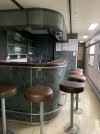Looks like the signaller has remote control of the points at least, possibly able to set routes by entrance exit through the interlocking, even if the signals are all marked OOU and dark, though still acting as block markers for the degraded working. The second train was initially slowing to a stop before presumably getting a verbal order by radio to continue when presumably the signaller had confirmation points were correctly aligned. I expect with limited resources, technicians usually concentrate on keeping track circuits and points through junction areas working.If anyone wants a video that epitomises Greek railway culture then watch this video. I am genuinely shocked by what happens at 06:40.
-
Our booking engine at tickets.railforums.co.uk (powered by TrainSplit) helps support the running of the forum with every ticket purchase! Find out more and ask any questions/give us feedback in this thread!
You are using an out of date browser. It may not display this or other websites correctly.
You should upgrade or use an alternative browser.
You should upgrade or use an alternative browser.
Larissa, Greece: Freight train collides with passenger train (01/03/2023)
- Thread starter antharro
- Start date
- Status
- Not open for further replies.
Sponsor Post - registered members do not see these adverts; click here to register, or click here to log in
R
RailUK Forums
ac6000cw
Established Member
That is my take on it too.I guess that all of those signals are marked out of use by the white cross
The tracks to the right appear to be main running lines, and look brand new but not in use (a bit rusty on top) with big heaps of ballast nearby, so there's probably modernisation going on (or has been recently).
Sounds quite a plausible explanation/situation to me. If the signals were working, the left-hand freight train would probably be rolling slowly towards a stop signal at the end of the loop, so it wouldn't be very different to what is happening in the video (in terms of train movements).Looks like the signaller has remote control of the points at least, possibly able to set routes by entrance exit through the interlocking, even if the signals are all marked OOU and dark, though still acting as block markers for the degraded working. The second train was initially slowing to a stop before presumably getting a verbal order by radio to continue when presumably the signaller had confirmation points were correctly aligned. I expect with limited resources, technicians usually concentrate on keeping track circuits and points through junction areas working.
(...and interesting to see some nearly 50-year old MLW/ALCo locos still hard at work - their exhausts seem surprisingly clean for ALCo's
 )
)
Last edited:
Perhaps not inappropriate for infrequent low-speed operations stopping at all stations by the small very old diesel units employed.I travelled around most of the (then metre gauge) Greek Peloponnese rail system 20 years ago, and I remember seeing very little formal signalling - I assume it was operated using train orders/telephone block.
ac6000cw
Established Member
Agreed (I wasn't at all surprised that it was operated like that). Rolling stock - back in 2003 - was mostly DMUs (both modern and old-ish, plus some locos and fairly old-looking carriages).Perhaps not inappropriate for infrequent low-speed operations stopping at all stations by the small very old diesel units employed.
Gag Halfrunt
Member
- Joined
- 23 Jul 2019
- Messages
- 579
The MLWs always seem to run in pairs with a cab facing each way, even for short trains. Is this so that drivers don't have to look down the length of the locomotive?
I visited in the 1980s. Mostly old DMUs in short formation then, certainly the 1950s units, possibly some of the earlier 1930s examples still in service. Athens - Patras, the busiest section which is now standard gauge, was the exception, with fairly lengthy trains hauled by big US-style diesel locos. On the loco-hauled I remember 1st class seats that could be swivelled 180 degrees, the first time I had encountered these. The bridge over the Corinth canal was also rather memorable, looking down on big ships passing beneath.Agreed (I wasn't at all surprised that it was operated like that). Rolling stock - back in 2003 - was mostly DMUs (both modern and old-ish, plus some locos and fairly old-looking carriages).
ac6000cw
Established Member
Almost certainly - 'short hood forward' operation (as Americans say). Running as back-to-back pairs means locos don't need to be turned around and provides some redundancy in case one fails. BR often did the same with the class 20s for the same reason, even though (AFAIK) they did have dual cab controls.The MLWs always seem to run in pairs with a cab facing each way, even for short trains. Is this so that drivers don't have to look down the length of the locomotive?
Like this one (a 1965-vintage ALCo parked at Pyrgos in 2003):I visited in the 1980s. Mostly old DMUs in short formation then, certainly the 1950s units, possibly some of the earlier 1930s examples still in service. Athens - Patras, the busiest section which is now standard gauge, was the exception, with fairly lengthy trains hauled by big US-style diesel locos. On the loco-hauled I remember 1st class seats that could be swivelled 180 degrees, the first time I had encountered these. The bridge over the Corinth canal was also rather memorable, looking down on big ships passing beneath.
[url=https://flic.kr/p/PYNNaH]
 PICT0051 by ac6044cw, on Flickr[/URL]
PICT0051 by ac6044cw, on Flickr[/URL]
Last edited:
As a former part-owner of a brace of class 20s, I can confirm they had dual controls, mechanically linked under the cab floor. They initially operated singly on local light freight traffic, but by the 70s most of that had disappeared to road haulage and the locos survived for another decade and more coupled in pairs on power station unit coal trains, where they had great haulage capability with their 8 axles. I think unions were actively against driving hood forward. I remember the entire wiring schematic, including the main traction power cables to the motors fitted readably on a single sheet of A4 paper. That simplicity made them incredibly reliable. Some of the class were made much more complicated with a later control modification for walking speed continuous MGR (merry-go-round) (un)loading operations at mines and power plants.Almost certainly - 'short hood forward' operation (as Americans say). Running as back-to-back pairs means locos don't need to be turned around and provides some redundancy in case one fails. BR often did the same with the class 20s for the same reason, even though (AFAIK) they did have dual cab controls.
Yes, that brings back memories. It was quite a fast run behind one of these on the Patras - Athens section I recall, in contrast to the slow meandering on most of the metre gauge.Like this one (a 1965-vintage ALCo parked at Pyrgos in 2003):
Last edited:
12LDA28C
Established Member
I think unions were actively against driving hood forward.
I believe there was and probably still is an instruction that if a Class 20 were to be driven 'nose-first' then a secondman was required for signal sighting and so on. If I'm not mistaken, the nose end is strangely Number 1 end with the cab being at Number 2 end.
Intercity110
On Moderation
don't they have ETCS there?
ac6000cw
Established Member
Read the earlier posts (answer is 'should have but not finished/not started/money ran out/squandered etc.').don't they have ETCS there?
Also, because it's a Level 1 overlay, it relies on existing lineside signalling working correctly, which it doesn't in many places. I noticed from cab videos up-thread there are numerous balises installed in the 4-foot, many at signals extinguished or passed at red.Read the earlier posts (answer is 'should have but not finished/not started/money ran out/squandered etc.').
This is Greece we are talking about....don't they have ETCS there?
They spent a fortune building new railway lines to replace the old routes, but the Signalling is still done by 'Red Cap' at the station or passing loop, think 'Absolute Block' type Signalling with a Signal Box at every station and there is a pointsman at either end of the station to set the points.
jamesontheroad
Established Member
- Joined
- 24 Jan 2009
- Messages
- 2,047
Tangential to the ongoing discussion, but perhaps interesting to readers, are a handful of videos I shot while travelling the day before the accident. First, a very tired class 520 diesel set arrives from Drama in Strimon (08:10) to take me to Thessaloniki (10:26) as train 1631.
View attachment trim.A01386D1-D06F-46D4-95AF-645A4F138927.MOV
Then some views out of the window along the way: an intermediate station (several stops on the way to Thessaloniki were not in the timetable I had found) and then on approach to Thessaloniki where we joined the electrified main line to Athens.
View attachment trim.9958C40B-D31C-4DD6-9FAC-5650C1D0CA66.MOV
View attachment trim.88853D6A-374C-4213-8B22-CF96894E5C1B.MOV
View attachment trim.A01386D1-D06F-46D4-95AF-645A4F138927.MOV
Then some views out of the window along the way: an intermediate station (several stops on the way to Thessaloniki were not in the timetable I had found) and then on approach to Thessaloniki where we joined the electrified main line to Athens.
View attachment trim.9958C40B-D31C-4DD6-9FAC-5650C1D0CA66.MOV
View attachment trim.88853D6A-374C-4213-8B22-CF96894E5C1B.MOV
duesselmartin
Established Member
those units are now more than 40 years old and still going despite mediocre maintanance .
ac6000cw
Established Member
Unfortunately I suspect that sums up the general state of Greek railways...still going despite mediocre maintenance.
Gag Halfrunt
Member
- Joined
- 23 Jul 2019
- Messages
- 579
those units are now more than 40 years old and still going despite mediocre maintanance .
The class 520s aren't quite as old as that. The four-car units (former class 601) were built in 1989 and the five-car units (former class 651) in 1995. (Source: Railfaneurope stock table.)
jamesontheroad
Established Member
- Joined
- 24 Jan 2009
- Messages
- 2,047
those units are now more than 40 years old and still going despite mediocre maintanance .
The class 520s aren't quite as old as that. The four-car units (former class 601) were built in 1989 and the five-car units (former class 651) in 1995. (Source: Railfaneurope stock table.)
Here are some pics of the interior. I parked myself in the second-class compartment (blue 2+2 seats in the photos) in the rear half of the leading carriage, right behind the motor unit. The noise of an engine mounted above the chassis behind a simple partition bulkhead was somewhat reminiscent of the old NIR Castle Class DMUs. I glimpsed the guard checking tickets in the next carriage but she never came through to see me. In the second carriage was a small first-class section (green seats, 2+1), then a dining car and bar. Neither of the latter appeared to have been used in years: a sad memory of when these trains were the glamorous cutting edge of "high-speed" train travel between Athens and Thessaloniki.





That was never intended. Modern continuous colour light signalling, much of it designed and commissioned by British Engineers, was installed on rebuilt and modernised sections. The problem is it doesn't all work properly today, so old methods must have been substituted where necessary to keep traffic moving. There were illustrations in an article linked upthread showing a station control panel at Larissa. The area of control on it was fairly small, but that is fairly typical of a local panel on continental railways. In UK, many older colour light signalling installations based on distributed relay-based interlocking also have so-called 'emergency panels' in their relay rooms for scenarios where the remote telemetry from a larger centre has failed. Returning to Greece, the presence of that local station control panel doesn't mean that a wider area isn't controlled by a larger control centre which is implied from other linked information referring to a Larrissa 'TCC' (traffic control centre?). Often the configuration of such installations is that the larger centre can route trains through on the main line and perhaps certain divergent movements, but if significant shunting etc is intended control can be handed over to the local panel for the duration then handed back after completion, like a large 'ground frame' in UK terminology. If this is the case at Larissa, the ongoing failure scenario may have resulted in control being effectively handed over permanently to the local control, but the lack of effective interlocking due to numerous failures makes any 'slotting' between the different levels of control impossible and could lead to misunderstandings between the operators.This is Greece we are talking about....
They spent a fortune building new railway lines to replace the old routes, but the Signalling is still done by 'Red Cap' at the station or passing loop, think 'Absolute Block' type Signalling with a Signal Box at every station and there is a pointsman at either end of the station to set the points.
Last edited:
Gag Halfrunt
Member
- Joined
- 23 Jul 2019
- Messages
- 579
BBC News report about the political consequences of the disaster:


Greece train crash: Rage at elite over young victims of rail tragedy
Dimitra was one of many students killed in a crash that has unleashed anger over neglect in the railway.
www.bbc.co.uk
This rage against the system is already having a profound influence on Greece's political landscape. Mr Mitsotakis had been almost certain to call an early election for April, before his term ends in July. The train wreck changed his plans.
Elections will be postponed with a backlash that could cost the centre-right New Democracy party dearly at the ballot box. Its earlier lead over the main opposition party has shrunk, while many fringe and protest parties have gained ground.
The rail disaster has hit the prime minister hard, says Aristides Hatzis, professor of legal theory at the University of Athens, because it damages one of his major selling points. Mr Mitsotakis has always presented himself as a competent manager and liberal technocrat, one to overhaul Greece and lead the country to modernisation.
His government has regularly highlighted its success in modernising some of Greece's creaking public sector operations. But putting the tax system online is understandably overshadowed by voters' realisation that their rail network is a veritable death trap.
For Prof Hatzis, the greatest danger Greece is now facing is in people losing faith in the political system: "Such collapse of legitimacy has historically worked in favour of the extreme right."
- Status
- Not open for further replies.
